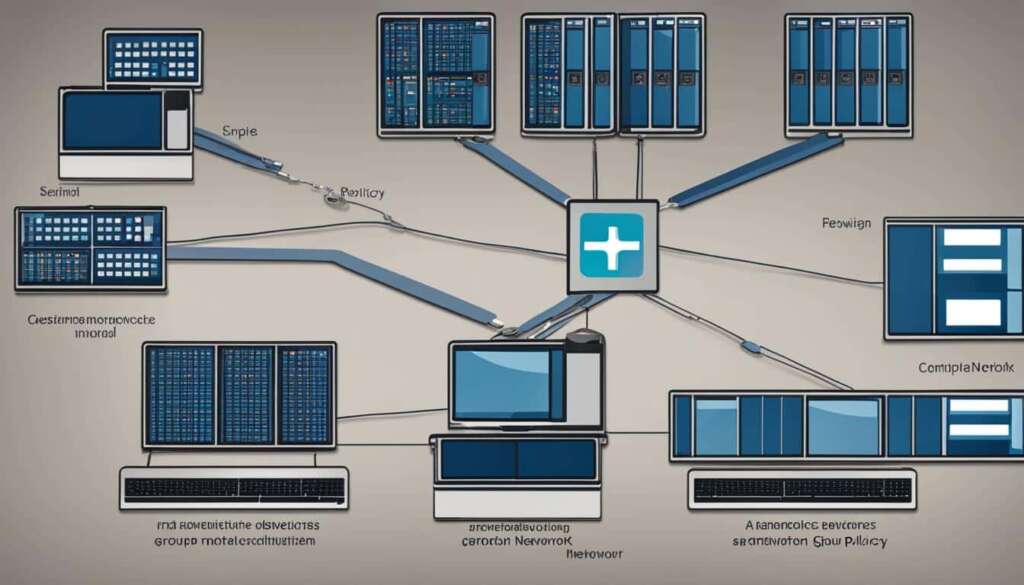Table of Contents
In IT management, Group Policy is a crucial tool that allows administrators to control and manage different systems effortlessly. It provides centralized control over networked computers and user settings, making it easier to apply consistent policies and configurations across multiple machines. Group Policy ensures efficient and effective administration of IT environments, making it a must-have for any organization that wants to streamline its IT infrastructure.
In this section, we will explore the concept of Group Policy and its benefits. We will discuss how this feature in Windows operating systems allows administrators to manage and control desktop configurations, user settings, and security policies across multiple computers in a network, offering a centralized approach to defining and enforcing security and management policies.
Key Takeaways
- Group Policy is a vital tool for efficient and effective IT infrastructure management.
- It offers centralized control over networked computers and user settings.
- Allows for consistent deployment of software applications and updates.
- Enforces security policies, such as password requirements and software restrictions.
- Understanding Group Policy and its management techniques is essential for successful IT management.
What is Group Policy?
Group Policy is a feature in Windows operating systems that allows administrators to manage and control desktop configurations, user settings, and security policies across multiple computers in a network. It provides a centralized approach to defining and enforcing security and management policies, streamlining IT administration tasks and reducing the risk of errors or inconsistencies.
Using Group Policy, IT administrators can define and enforce policies for user accounts, network configurations, and system settings. This simplifies IT management by allowing administrators to manage multiple computers and users simultaneously, ensuring that all devices are configured consistently and securely.
The benefits of implementing Group Policy include a substantial reduction in IT administration time and resources, improved security and compliance, and a more consistent user experience across multiple devices. By centralizing the management of system configurations, Group Policy is an essential tool for managing large-scale IT environments with multiple users and devices.
Benefits of Group Policy in IT Management
Implementing Group Policy offers numerous benefits in IT management. It allows administrators to enforce security policies, such as password requirements and software restrictions, ensuring a secure network environment.
Group Policy also allows for the consistent deployment of software applications and updates, simplifying the management of software across multiple machines.
Additionally, it facilitates the customization of user interfaces and settings, tailoring the computing experience to specific user roles or departments.
Managing Group Policy Objects (GPOs)
Group Policy Objects (GPOs) act as containers for the settings and policies that are applied to specific computers or users. When properly managed, GPOs offer numerous benefits in ensuring consistent computer configurations and security across an organization’s IT network.
Administrators have the power to create, modify, and link GPOs to different Active Directory organizational units, allowing for greater flexibility in maintaining the network. Instead of having a singular policy setting for an entire organization, GPOs permit the application of granular settings that are specific for different departments or groups.
These settings can range from security protocols, such as password requirements and software restrictions, to customized user interfaces and settings that meet individual specifications. GPOs can configure settings related to logon/logoff scripts, folder redirection, and much more, making an organized and efficient approach to system management.
Proper management of GPOs is critical to successful IT administration. Failing to enact adequate control may compromise data security, leading to errors and inconsistencies. To maintain efficient and consistent administration of the IT environment, administrators must ensure that GPOs are well-structured, organized, and in line with the requirements of the organization.
Example: Management of GPOs
| Department | GPO Settings |
|---|---|
| Sales |
|
| Research and Development |
|
Conclusion
Group Policy is a critical tool for IT management, offering centralized control over networked systems and user settings. By implementing Group Policy, administrators can streamline the administration of IT environments, enforcing security policies and ensuring consistent configurations across multiple computers.
The benefits of Group Policy include the ability to enforce security policies, such as password requirements and software restrictions, providing a secure network environment. Additionally, it allows for the consistent deployment of software applications and updates, simplifying the management of software across multiple machines. Group Policy facilitates the customization of user interfaces and settings, tailoring the computing experience to specific user roles or departments.
Managing Group Policy Objects (GPOs) is an essential aspect of successful IT management. GPOs are containers that house the settings and policies applied to target computers or users, enabling granular control over different departments or groups. GPOs can be used to configure settings related to security, software installation, logon/logoff scripts, folder redirection, and much more.
In conclusion, understanding the concept of Group Policy and its various benefits and management techniques is crucial for efficient and effective IT infrastructure management. By leveraging Group Policy, administrators can simplify administration tasks, streamline processes, and ensure a secure and stable network environment.
FAQ
What is Group Policy?
Group Policy is a feature in Windows operating systems that allows administrators to manage and control desktop configurations, user settings, and security policies across multiple computers in a network.
What are the benefits of Group Policy in IT management?
Implementing Group Policy offers numerous benefits in IT management. It enables administrators to enforce security policies, such as password requirements and software restrictions, ensuring a secure network environment. Group Policy also allows for the consistent deployment of software applications and updates, simplifying the management of software across multiple machines. Additionally, it facilitates the customization of user interfaces and settings, tailoring the computing experience to specific user roles or departments.
How do you manage Group Policy Objects (GPOs)?
Group Policy Objects (GPOs) are containers that house the settings and policies applied to target computers or users. Administrators can create, modify, and link GPOs to different Active Directory organizational units, enabling granular control over different departments or groups. GPOs can be used to configure settings related to security, software installation, logon/logoff scripts, folder redirection, and much more. Understanding how to effectively manage GPOs is crucial for successful IT management.












